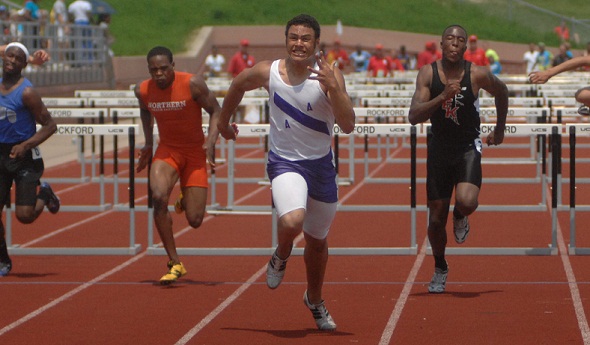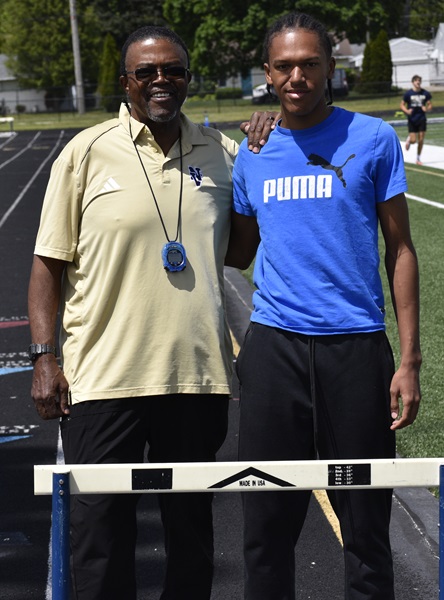
Pioneer's Johnson Focused on Finish
May 24, 2012
By Geoff Kimmerly
Second Half editor
At 6-foot-1 and a solid 205 pounds, Drake Johnson looks every bit the college running back he’ll become this fall at the University of Michigan.
And amid chasing the MHSAA record for single-season rushing yards this fall, he became a recognizable face as well.
But not long ago, Johnson was known primarily for the elite times he ran during track season. And that allowed the Ann Arbor Pioneer hurdler to have a little extra fun.
A self-admitted jokester, Johnson would get a chuckle before races while watching opponents keep a lookout for him, not realizing he was standing next to them.
“Let’s see who they think I am before the race,” Johnson would say to himself. “And once they figured out who I am, they’d be like, ‘No way! This can’t be Drake.’
“I’d just win the race.”
Now there are few in MHSAA track and field who don't recognize him – or know of the legacy he's about the leave.
Johnson is a two-time MHSAA Division 1 champion in the 110-meter hurdles, and won both that race (14.25) and the 300 hurdles (38.63) at Friday's Division 1 Regional at Saline. He owns the Pioneers’ record in the 110 hurdles of 13.7 seconds, and also will run as part of the 1,600 relay at next weekend’s Division I Final at East Kentwood High.
A Second Half High 5 recipient this week, Johnson has two goals for his final high school meet: Break the all-Finals record in the 110 of 13.6 seconds set by Detroit Central’s Thomas Wilcher in 1982, and win the 300 intermediate hurdles – a race he qualified for last season, but did not advance in past the preliminaries.
Johnson won both hurdles races at last weekend's Regional by more than a second – margins that also have become the norm. After finishing third in the 110 hurdles as a freshman at the 2009 Division 1 Final, Johnson won that race in 2010 by 34 hundredths of a second and last season by 44 hundredths.
His 13.9 Finals qualifying time this spring is the second-fastest among all four divisions. And his best time in high school competition – 13.7 – is faster than them all.
“He’s always had high aspirations to do really well,” said Pioneer coach Don Sleeman, who is finishing his 39th season coaching the Pioneers' boys team. “He’s basically been (this) way from the get-go. I’ve had kids you could see as freshmen would be really good if they developed … but Drake was really good from freshman year on. His talent was pretty obvious.”
And it’s not restricted to hurdles. Johnson would do just fine as a sprinter – for example, he’s beaten Ann Arbor Skyline’s Nathan Hansen, who posted the fifth-fastest Division 1 qualifying time in the 100 of 10.8 seconds. Johnson uses his strength to power through races like he has a ball tucked under his arm, continuously accelerating as others begin to fade.
And the hurdles offer a canvas on which he can create what he describes as his art.
“Everyone has a top speed. It's only one variable -- are you fast, or are you not fast? With hurdles, … it’s a combination of speed and hours of working on technique,” Johnson said. “There's almost that second variable to it, that X factor. A lot of people … can work on technique for hours and hours.
"It’s deeper, but at the time, it’s so incredibly simple. Whoever gets there faster wins the race. Whatever form allows me to finish the fastest, then technically I have better form than you do.”
Johnson has seven entries in the MHSAA football record book, thanks to his incredible numbers in the fall. In 12 games, Johnson ran 344 times for 2,809 yards and 37 touchdowns, and scored 38 times total. His yardage is sixth-most for one season in MHSAA history.
A downfall of his final run through high school track has been the outside expectation that he would post super-fast times in every race – although doing so hasn't always been necessary to win. Sometimes, Johnson focused more on working on nuances, or saving up energy for other events.
But he’s looking forward to one last opportunity to let fly before moving down the road and onto the next level of competition.
“Knowing that it’s my last chance to get the record, I have a sense of urgency almost,” Johnson said. “Also, if I had an actually good start, and a full race, if I run the way I feeI could run it, I’m hoping I could possibly go 13.1 – if I were to run the perfect race.”
Click to read more about Johnson's career aspirations and favorite football runners.
PHOTO: Ann Arbor Pioneer's Drake Johnson won last season's MHSAA Division 1 110 hurdles Final by nearly half a second.
McCarey Caps Niles Career Among School's All-Time Track Greats
By
Scott Hassinger
Special for MHSAA.com
June 3, 2025
NILES – For such a decorated athlete, Niles track & field star Ayden McCarey is as humble as they come.
 That one trait is what makes him such a joy to coach, says Tony Todd, the Vikings' longtime leader of the boys program.
That one trait is what makes him such a joy to coach, says Tony Todd, the Vikings' longtime leader of the boys program.
Todd, a Flint Kearsley graduate and former participant himself in the oval sport, has seen many great performers during his 27 years directing Niles' program. But he contends that McCarey is one of the best he's ever coached.
McCarey, who has signed to run track at the Division II level at Grand Valley State University, capped off a glorious high school career during Saturday's Lower Peninsula Division 2 Finals in Hamilton.
McCarey returned home with all-state honors in two events, finishing second in the 110-meter high hurdles (14.43) and third-place in the 400-meter dash (49.27). His time in the 110s broke the school record. He has the second-fastest time at the school in the 400 dash, less than a second behind 2018 Niles grad Jordan Brown, currently the Vikings' sprint coach, who owns the record at 48.50.
McCarey also qualified in the 300 intermediate hurdles and ran anchor leg for the Vikings' 1,600 relay on Saturday.
"Ayden relishes the competition. The bigger the meet, the more he seems to rise to the occasion and perform well. When someone has a faster time, he can't wait to race against them. He gets excited over the chance to compete against someone faster," Todd said.
Also a standout defender for the Niles boys soccer team, McCarey finished runners-up in both the 110 highs and 400 his junior year. As a sophomore he placed sixth in the 110 and 10th in the 300. He began competing in the 400 midway through his sophomore season.
"It's just nice to know that all your hard work you put in got you to state. There's a lot of competition there. I am just happy to represent my school for a third time," McCarey said.
He credits an increase in distance workouts and his increased focus on the 400 as big reasons for his improvement in that event this season.
 "I try and focus on all my events, but it just so happened I spent the most time focusing on the 400 this season,” McCarey said. “You need a lot of stamina to run that event, and it also helps me in the longer hurdle race as well. I've been successful in the 110 highs because I concentrate on attacking it whereas most people sometimes hop over them and that slows them down and hurts their time. I get a good start, and I'm able to maintain my speed throughout the race."
"I try and focus on all my events, but it just so happened I spent the most time focusing on the 400 this season,” McCarey said. “You need a lot of stamina to run that event, and it also helps me in the longer hurdle race as well. I've been successful in the 110 highs because I concentrate on attacking it whereas most people sometimes hop over them and that slows them down and hurts their time. I get a good start, and I'm able to maintain my speed throughout the race."
McCarey owned the fastest time in the 400 among Lower Peninsula Division 2 competitors after the Regional meet. He was ranked second in the 110 highs and fourth in the 300 entering the Finals.
"Ayden goes non-stop and never complains. He's one of those kids that will run through a wall for you,” Todd said. “Sometimes I take advantage of that to get that extra effort out of him. He is very humble, and if you try and compliment him he just smiles and puts his head down and keeps going. I worry more than he does if he doesn't get the accolades that he should. He is a quiet kid who leads by example. His form in the hurdles has improved all four years."
McCarey went through his entire high school track career without an injury.
"That's a big thing. Coaches have to learn when to pull back. He's never had a serious injury that left him having to sit out a practice. You can attribute that to his extraordinary work ethic because if you slack off, that's one of the easiest ways to get hurt,” Todd said. “He stays in shape year round with his participation in soccer and track. He is very versatile and can compete at the state level in any event from the 100 up to the 400, along with the hurdles and relays.
"His conditioning and running that he does during his soccer practice builds his endurance for track. In turn, the speed he's developed in track helps him out on the soccer field."
McCarey is looking forward to competing in college.
"I decided to go to Grand Valley because they have a solid track program, and it’s not that far from home. I liked their business program there too," McCarey said.
Todd is looking forward to seeing what McCarey can do at the next level.
"The biggest thing that will make Ayden a valuable competitor in college is that he is a natural athlete. There is only so much you can coach,” Todd said. “It takes a good coach and a good athlete to make a champion. But 90 percent of that is the athlete. If they listen and do the workouts, they will succeed.
"I couldn't be more proud of his four-year high school career. He had the most outstanding track career ever at Niles High School, and he's a great human being and student. This young man is going to do great things at Grand Valley and in life. I'm proud to have been his coach for his entire high school career."
 Scott Hassinger is a contributing sportswriter for Leader Publications and previously served as the sports editor for the Three Rivers Commercial-News from 1994-2022. He can be reached at [email protected] with story ideas for Berrien, Cass, St. Joseph and Branch counties.
Scott Hassinger is a contributing sportswriter for Leader Publications and previously served as the sports editor for the Three Rivers Commercial-News from 1994-2022. He can be reached at [email protected] with story ideas for Berrien, Cass, St. Joseph and Branch counties.
PHOTOS (Top) Niles senior Ayden McCarey leaves the starting block during the 1600-meter relay at his team’s Regional. (Middle) Niles coach Tony Todd, left, takes a photo with McCarey before the start of a practice last week. (Photos by Scott Hassinger.)

